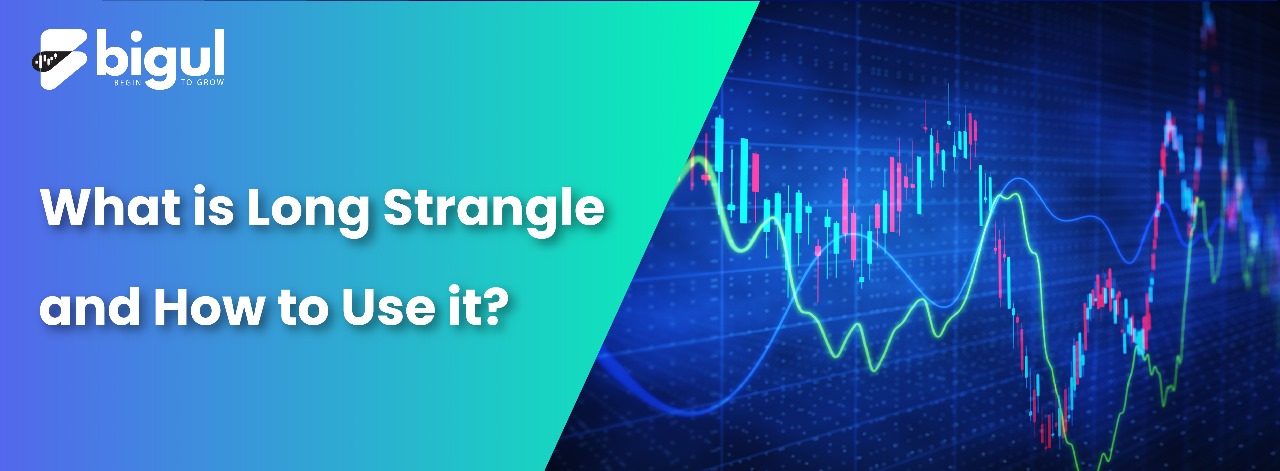In options trading, strategies abound, each designed to capitalise on specific market conditions and expectations. Among these strategies, the long strangle stands out as a versatile and potentially lucrative approach.
This option strategy involves buying both call and put options on the same underlying asset, with the anticipation of significant price movement in either direction. Traders and investors use it to profit from financial market volatility and uncertainty. This post will explain the strangle strategies, their benefits, components, and more.
Also Read | What is the Short Strangle Option Strategy? Bigul
What is Long Strangle and How to Use it?
A long strangle is an options trading strategy that’s employed when an investor expects significant price movement in an underlying asset but is uncertain about the direction of that movement. It involves buying both a call option and a put option with the same expiration date but different strike prices. The call option allows the trader to profit from upward price movement, while the put option provides profit potential if the price falls. The key to using a long strangle effectively is volatility. This strategy thrives when the market experiences substantial price swings, as it benefits from the asset’s movement in either direction.
Traders need the asset’s price to move significantly beyond the combined cost of both options to make a profit. However, the potential loss is limited to the initial investment in both options.
Components of a Long Strangle Option Strategy
The long strangle option strategy is characterised by several key features:
-
Directional Neutrality
The long strangle is a versatile options strategy known for its directional neutrality. Unlike other strategies that depend on predicting price movement in a specific direction, the long strangle capitalises on significant price swings, whether the underlying asset’s prices rise or fall. Traders use this approach when they anticipate market volatility but are uncertain about the exact direction of the price movement. By holding both a long call (bullish) and a long put (bearish) option simultaneously, they are prepared to profit from substantial price fluctuations. This makes it a strategy well-suited for volatile and uncertain market conditions.
-
Two Option Types
The long strangle strategy involves purchasing two distinct types of options: a long call option and a long-put option. The long call option is chosen for bullish expectations, allowing the trader to profit if the underlying asset’s price increases. The long-put option is selected for bearish sentiments, enabling profit when the underlying asset’s price decreases. This combination provides the trader with the flexibility to capitalise on significant price movements, regardless of whether they anticipate a rise or fall in the asset’s value, making it a directionally neutral strategy.
-
Out-of-the-Money Strikes
In the long strangle strategy, both the call and put options typically have strike prices that are out-of-the-money (OTM). This means the strike prices are not currently favorable for exercise based on the current market price of the underlying asset. OTM options are chosen because they are cheaper to purchase compared to in-the-money (ITM) options, reducing the initial cost of the strategy. However, they require the underlying asset’s price to make a substantial move in either direction for the options to become profitable, as they need to move into the money before expiration.
-
Breakeven
In a long strangle strategy, there are two breakeven points, which are important reference points for evaluating the profitability of the strategy. These points help you understand the price range within which your strategy becomes profitable or unprofitable.
Here’s an explanation of each breakeven point:
- The upper breakeven is the point at which the underlying asset’s price equals the sum of the strike price of the call option and the total premium paid on both options.
- The lower breakeven occurs when the put option’s strike price minus the underlying asset’s price equals the total premium paid for both options.
These breakeven points represent the price levels at which the strategy starts to become profitable. Above the upper breakeven, the call option begins to make a profit.
Whereas below the lower breakeven, the put option becomes profitable, making it a versatile strategy for profiting from significant price movements in either direction.
-
Volatility
Volatility is crucial in a long strangle strategy. This strategy thrives on increased price fluctuations in the underlying asset. Higher volatility creates a greater likelihood of substantial price movements, which is advantageous for the strategy. When volatility rises, the chances of one of the options (call or put) moving into profitability increase, potentially resulting in larger gains.
Therefore, investors using a long strangle actively seek environments with heightened market volatility to maximise their profit potential in response to significant price swings.
Benefits of the Long Strangle
The long-strangle strategy offers several benefits to investors and traders, primarily when they expect significant price volatility in the underlying asset but are uncertain about the direction of the price movement.
Here are some of the key benefits of using a long-strangle strategy:
- Profit from Volatility: The long strangle benefits from volatile markets by enabling traders to profit from significant price swings, whether the underlying asset rises or falls sharply. This flexibility makes it an effective strategy during events like earnings reports or product launches, where substantial price fluctuations are anticipated.
- Limited Risk: The long strangle strategy offers limited risk, as the maximum potential loss is confined to the total premiums paid for both the call and put options. This means traders have a well-defined and manageable level of risk exposure, providing peace of mind. Even in highly volatile markets, where price swings can be substantial, the worst-case scenario is known upfront. This makes the long strangle strategy a relatively controlled approach to speculating on significant price movements.
- Unlimited Profit Potential: The long-strangle strategy offers unlimited profit potential, as it allows traders to capitalise on significant price swings in the underlying asset. Whether the asset’s price surges dramatically upward or plummets considerably downward, the strategy can generate profits without an upper limit. This feature makes it especially attractive for traders expecting substantial volatility, as they can potentially enjoy substantial gains as long as the market exhibits the anticipated price movement. However, their risk remains limited to the total premiums paid for the options.
- Low Capital Outlay: The long-strangle strategy offers a cost-effective approach to capitalise on significant price volatility because it involves lower capital investment compared to purchasing the underlying asset. Traders only pay premiums for call-and-put options, which typically cost less than acquiring the actual asset. This affordability makes it accessible to a wider range of investors and allows them to participate in volatile markets without committing a substantial amount of capital upfront.
- Diversification: Long strangle strategy offers diversification in an options portfolio. By using this strategy alongside other trading approaches, investors spread their risk. They aren’t solely reliant on a single directional bet, making their portfolio more resilient to market uncertainties. This diversification can provide a level of risk mitigation, as the success of the long strangle isn’t tied to a specific market direction.
Instead, it leverages volatility, allowing traders to participate in potentially profitable opportunities regardless of whether the underlying asset moves up or down.
When to Use a Long Strangle?
A long strangle strategy is most aptly deployed when financial markets exhibit signs of impending volatility or uncertainty. Traders use it when they anticipate a substantial price movement in an underlying asset but are uncertain about the direction of that movement. This strategy thrives on market turbulence and can be particularly useful during earnings reports, major economic events, or when a significant news catalyst is expected. By using a long strangle in such scenarios, traders aim to profit from the resulting price swings, regardless of whether they move upwards or downwards.
Steps to Execute a Long Strangle
Implementing a long strangle strategy involves several crucial steps:
- Choosing the underlying asset: Select an asset, such as a stock or Nifty 50 or Nifty Bank, where you anticipate significant price fluctuations but are uncertain about the direction of the movement.
- Selecting strike prices for call and put options: Select out-of-the-money (OTM) strike prices for both call and put options, ensuring they are far enough from the current asset price to allow for significant price movement in either direction.
- Calculating the total cost of the strategy: Calculating the total cost of the strategy involves determining the combined expense of purchasing both the call and put options, including fees and commissions, to assess your initial investment.
- Setting up orders to execute the long strangle: Setting up orders involves placing buy orders for the selected call and put options, specifying expiration dates and strike prices, and ensuring proper funding in your brokerage account for the trade.
These steps are crucial for establishing a long strangle position effectively. Proper execution and careful consideration of strike prices and costs are key to maximising the strategy’s potential.
Conclusion
The long-strangle strategy is a valuable tool in the world of options trading, offering traders the flexibility to profit from significant price movements in either direction. While it comes with risks, its potential rewards make it a compelling choice in volatile markets. Remember, success in options trading requires a solid understanding of the strategy and careful risk management. Before implementing a long strangle or any options strategy, it’s crucial to seek professional advice and practice sound decision-making to navigate the complexities of the financial markets effectively.
Also Read | 10 Things You Need to Know Before You Trade Options








.jpg)
.jpg)
